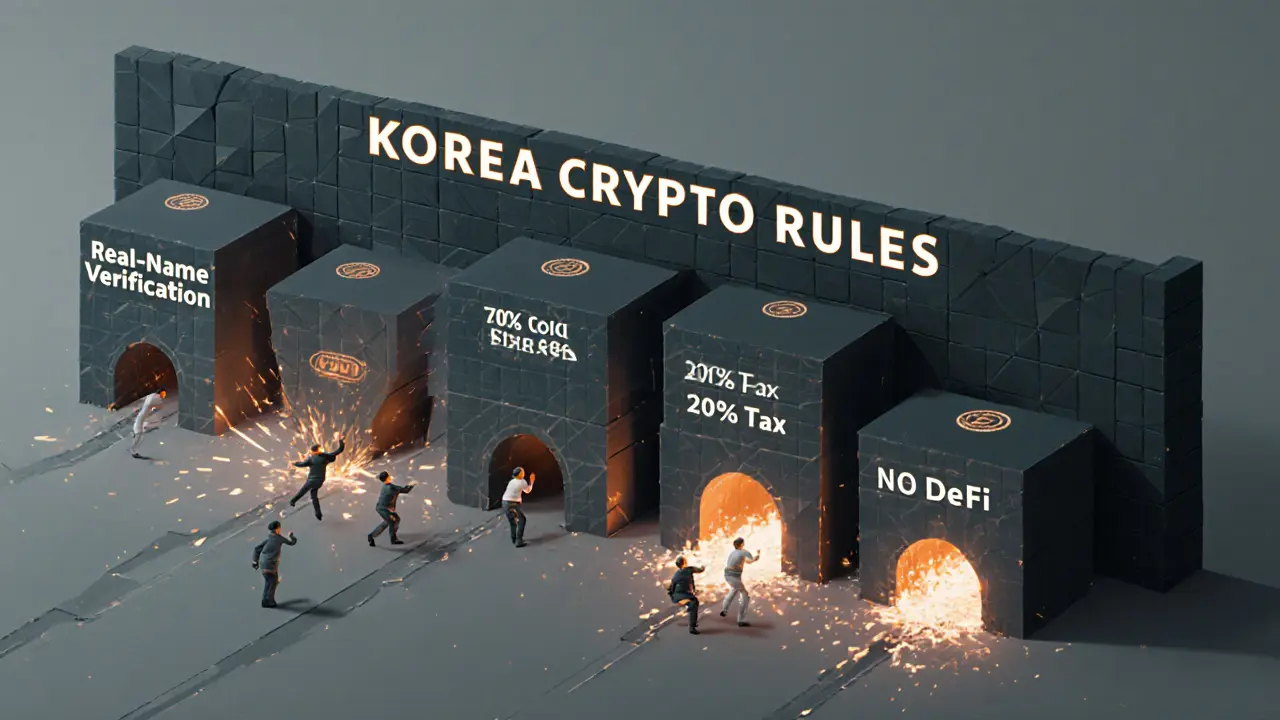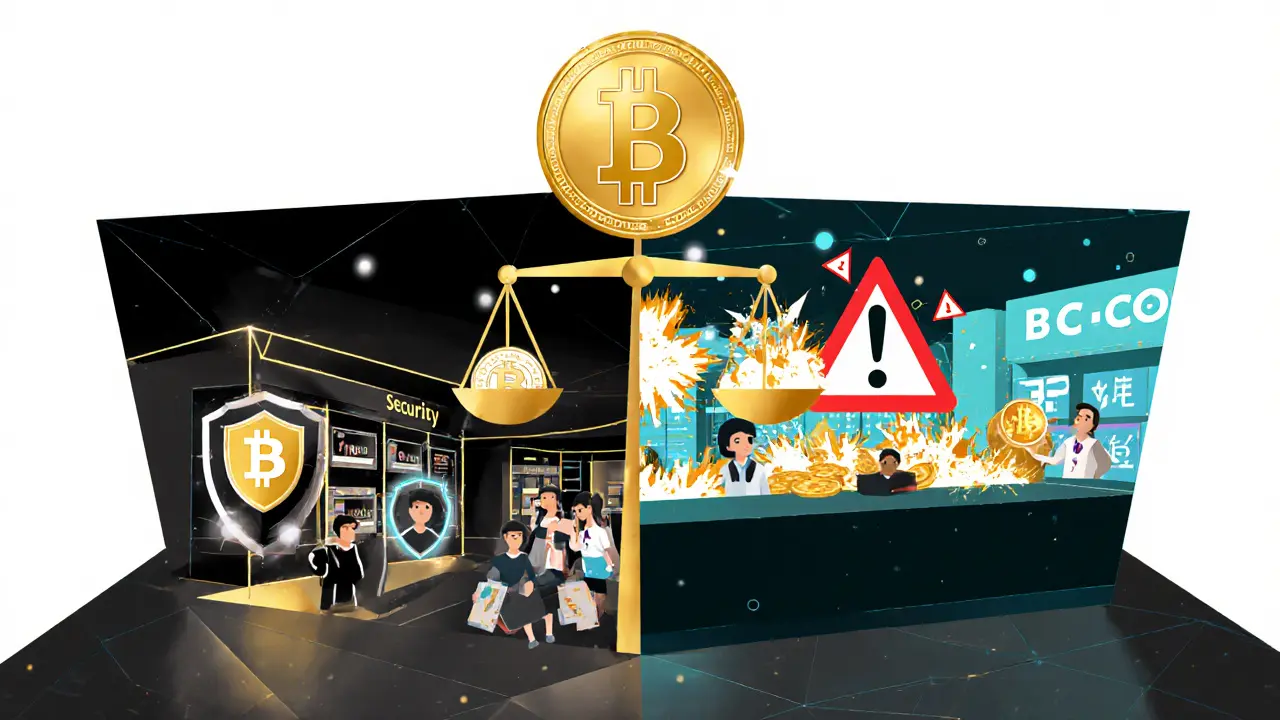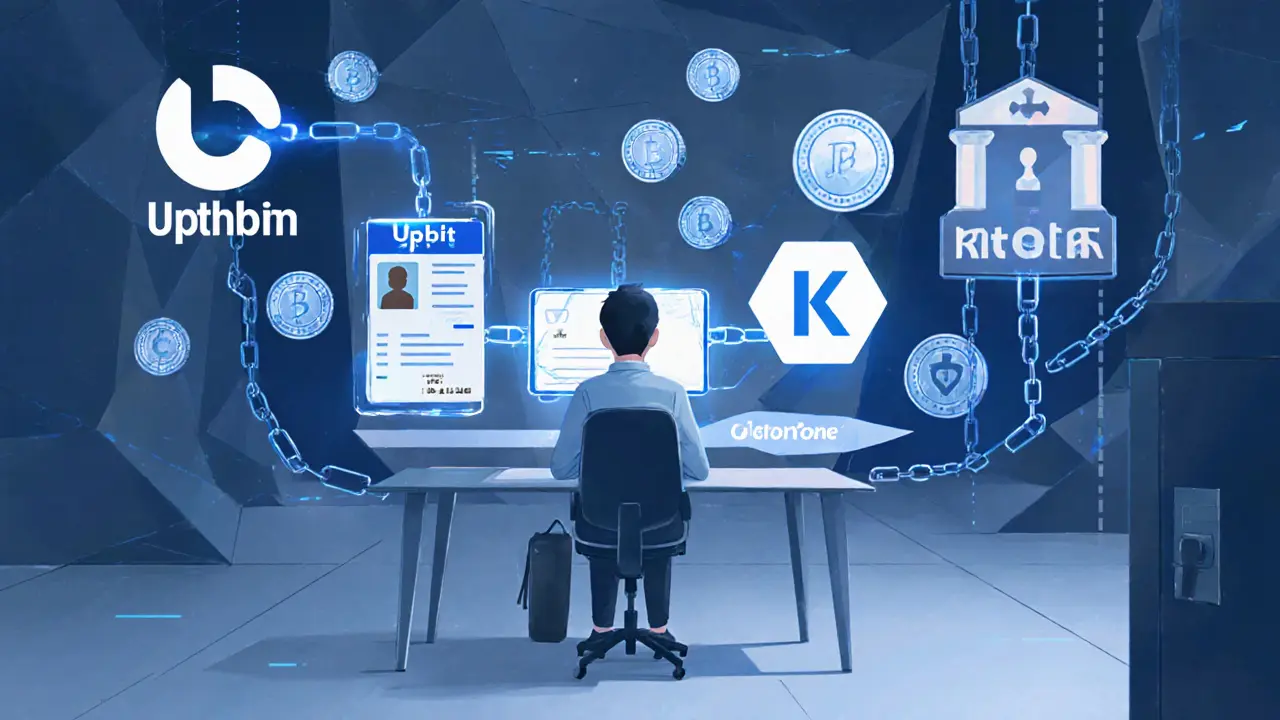Korea Crypto Tax Calculator
Calculate Your Korean Crypto Tax
Starting January 2025, Korea taxes cryptocurrency profits exceeding 2.5 million KRW (≈ $1,800 USD) at 20%. This calculator shows your tax liability based on your annual trading profits.
South Korea’s Crypto Market Is One of the World’s Most Controlled
If you’re trading cryptocurrency in South Korea, you’re not just using an app-you’re navigating one of the strictest financial systems on Earth. Unlike places where crypto is loosely regulated or outright banned, Korea has built a detailed, bank-backed cage around digital assets. It’s not about stopping crypto. It’s about controlling it. And it’s working.
As of October 2024, only four exchanges are legally allowed to operate: Upbit, Bithumb, Coinone, and Korbit. Together, they handle over 95% of all local trading volume. If you’re using any other platform, you’re breaking the law. And the government isn’t just watching-they’re actively shutting down unlicensed sites. Since 2021, more than 200 foreign and domestic exchanges have been forced offline.
Real-Name Verification: No Anonymous Trading Allowed
Since 2018, Korea has required every crypto trader to link their digital wallet to a real bank account under their legal name. This isn’t optional. You can’t sign up with a pseudonym, use a VPN, or trade through a friend’s account. The system is called real-name verification, and it’s enforced by partnerships with major banks like KB Kookmin, Shinhan, and NH Nonghyup.
Here’s how it works: You open an account on Upbit or Bithumb, then you link it to your Korean bank account. The exchange sends a request to your bank. The bank confirms your name, ID number, and account match. Only then can you deposit or withdraw KRW. No match? No trading. This system blocks money laundering, tax evasion, and fake accounts. It also makes it nearly impossible to use crypto for anonymous purchases or offshore transfers.
Security Rules That Actually Work
Korea doesn’t just require identity checks-it demands bulletproof security. Licensed exchanges must:
- Store at least 70% of customer crypto in cold wallets (offline, disconnected from the internet)
- Keep customer funds in segregated accounts, separate from company money
- Carry cyber insurance of at least 1 billion KRW ($750,000) per exchange
- Pass annual Information Security Management System (ISMS) certification
Since these rules took effect, not a single licensed Korean exchange has suffered a major hack. Compare that to global platforms like Binance or KuCoin, which have lost billions in thefts since 2023. Korean traders don’t worry about their funds vanishing. They worry about what’s not available.

What You Can’t Trade-And Why
There’s a trade-off for safety: choice. While Binance lists over 1,000 cryptocurrencies, Korean exchanges offer only 200 to 300. Many popular tokens-especially newer DeFi coins, memecoins, or tokens from unverified projects-are simply blocked.
Why? Because regulators demand that every listed asset pass a risk and compliance review. Tokens with anonymous teams, unclear use cases, or no audit trail get rejected. Even major coins like Solana or Polygon were slow to get listed because of extra scrutiny.
Traders complain. Reddit threads and Naver Cafés are full of posts like: "Why can’t I buy Arbitrum?" or "Why is this new AI token banned?" The answer is always the same: Korea prioritizes safety over speculation. If a coin can’t prove it’s not a scam, it doesn’t make the cut.
How to Start Trading-Step by Step
If you’re in Korea and want to trade legally, here’s what you need to do:
- Download one of the four licensed apps: Upbit, Bithumb, Coinone, or Korbit.
- Submit your Korean ID card or resident registration number.
- Link your real-name bank account (must be in your exact legal name).
- Complete a video verification call with customer support (takes 5-15 minutes).
- Wait 24-72 hours for bank confirmation.
- Deposit KRW via bank transfer-no credit cards, no PayPal, no crypto deposits from other wallets.
- Start trading.
It’s not fast. It’s not easy. But it’s legal. And it’s secure.
Taxes: 20% on Profits Over 2.5 Million KRW
Starting January 2025, Korea will tax crypto profits. If you make more than 2.5 million KRW ($1,800) in a year from trading, you pay 20% capital gains tax. That’s not a small number. For many retail traders, this means they’ll need to track every buy and sell.
Exchanges now provide annual tax reports, but you’re still responsible for filing. The National Tax Service has access to all transaction data from licensed platforms. Trying to hide earnings? You’re likely to get caught. Penalties include fines up to 40% of unpaid tax and criminal charges for fraud.

What’s Blocked: DeFi, International Exchanges, and More
It’s not just about exchanges. Korean banks actively block transactions to foreign crypto platforms. If you try to send KRW to Binance, Kraken, or Bybit, your bank will reject it. Some users try to use peer-to-peer (P2P) platforms or third-party payment services-but those are risky and often flagged as suspicious.
Decentralized finance (DeFi) apps like Uniswap or Aave are also hard to access. Many Korean users report that their mobile data or home Wi-Fi blocks connections to these sites. Even if you use a VPN, withdrawing funds back to a Korean bank account is nearly impossible without triggering alerts.
This isn’t a glitch-it’s policy. The government wants crypto activity confined to regulated channels where it can monitor every transaction.
Who Benefits? Who Loses?
On one side, retail investors win. Korean traders have the lowest rate of theft and fraud in the world. A 2024 survey of 1,200 users showed 87% were satisfied with security-far above the global average of 62%.
On the other side, innovation suffers. New crypto startups can’t easily launch in Korea. The cost of getting licensed is over 500 million KRW ($375,000) just for ISMS certification. That’s out of reach for most small teams. As a result, most blockchain innovation in Korea happens in corporate labs-not startups.
Some experts warn this could push talent overseas. "Korea’s rules are safe, but they’re also a wall," says Alex Kim, a blockchain consultant based in Singapore. "The best developers are moving to Hong Kong, Dubai, or even Estonia where the rules are clearer and lighter."
The Future: Stablecoins, CBDCs, and More Control
Korea isn’t slowing down. In September 2024, new rules forced exchanges to fully back stablecoins like USDT and USDC with real cash reserves and publish monthly audits. This makes them safer-but also less flexible.
Next up: the Central Bank Digital Currency (CBDC). The Bank of Korea plans to begin pilot testing its own digital won in early 2025. This could eventually replace private crypto for everyday payments. Some analysts believe the government sees CBDC as the final step: total control over digital money.
For now, Korea’s model works. It’s safe, transparent, and highly regulated. But it’s also closed. If you want freedom, you’ll have to go elsewhere. If you want security, you’ll stay-and pay the price in choice.
Can I trade crypto in South Korea legally?
Yes, but only through one of four licensed exchanges: Upbit, Bithumb, Coinone, or Korbit. All others are illegal. You must also complete real-name verification with a Korean bank account. No anonymous trading is allowed.
Why are so few crypto exchanges allowed in Korea?
The government requires strict licensing, including ISMS certification, bank partnerships, and cyber insurance. The cost and complexity are so high that only four major players have passed. This limits competition but increases security and compliance.
Can I use Binance or Coinbase in South Korea?
You can access their websites, but you can’t deposit or withdraw KRW through Korean banks. Most bank transfers to these platforms are blocked. Using P2P or third-party services to bypass this is risky and may violate financial laws.
Do I have to pay taxes on crypto profits in Korea?
Yes. Starting January 2025, profits over 2.5 million KRW ($1,800) per year are taxed at 20%. Exchanges provide tax reports, but you must file them yourself. The tax authority has direct access to all trading data from licensed platforms.
Why are so many coins banned on Korean exchanges?
Regulators require each token to pass a compliance review. Coins with anonymous teams, unclear purpose, or no audit trail are blocked. This reduces scam risk but limits trading options-Korean exchanges list only 200-300 coins versus 600+ on global platforms.
Can I use a VPN to trade on foreign exchanges?
Technically yes, but it’s risky. Korean banks monitor outbound transfers. If you send KRW to a foreign exchange, your account may be flagged. Withdrawing profits back to Korea is nearly impossible without triggering compliance alerts. You could face account freezes or legal scrutiny.
Is crypto trading popular in South Korea?
Yes. As of late 2024, there are over 4.6 million active crypto traders in Korea-about 9% of the population. It’s the fourth-largest crypto market globally, with daily trading volumes of $4-6 billion. Retail investors make up 94% of activity.
What’s the difference between Korean crypto rules and U.S. or Japanese rules?
The U.S. has no unified federal rules-regulation is patchy. Japan allows more exchanges and coins but has weaker custody rules. Korea requires real-name bank links, mandatory cold storage, insurance, and limits coin listings. It’s stricter, more centralized, and more secure-but less open.

Michael Heitzer
November 13, 2025 AT 17:26This system is insane in the best way. I’ve traded on Binance, Kraken, Coinbase - all of them. But after seeing how Korea locks down funds, I’m honestly jealous. No hacks. No rug pulls. No ‘oops I lost my private key’ drama. Just cold wallets, real-name checks, and banks that actually talk to exchanges. It’s not freedom - it’s financial adulthood.
Rebecca Saffle
November 15, 2025 AT 00:45Of course Korea wants control. They’ve been obsessed with order since the Korean War. This isn’t innovation - it’s surveillance with a side of tax receipts. If you want freedom, go to El Salvador. Or Switzerland. Or anywhere that doesn’t treat you like a child who can’t handle a wallet.
Adrian Bailey
November 16, 2025 AT 14:45man i just tried to sign up for upbit last week and holy crap it took 3 days. i had to do a video call with some guy in seoul who asked me if i was "really me" and then my bank sent a text that said "this transaction is being monitored by the national tax service" like wtf. but then i actually got my first btc deposit and it just sat there for like 2 weeks because they don’t let you trade new coins until they "review the whitepaper" and honestly? i kinda love it. i’m tired of buying shitcoins that vanish in 3 weeks. plus i don’t have to worry about my portfolio getting wiped by some hacker in russia. i’ll take bureaucracy over bankruptcy any day. also the tax report they give you is actually decent, unlike coinbase which just says "here’s a csv with 10k rows and no labels"
Rachel Everson
November 17, 2025 AT 02:14For anyone thinking this is too strict - imagine waking up and not having to check if your exchange got hacked. Imagine not losing your life savings because some anonymous dev launched a token with a Discord channel and no code audit. Korea’s system isn’t perfect, but it’s built for people who want to sleep at night. If you’re trading to get rich quick, sure, go find a wild west exchange. But if you’re trying to build real wealth? This is the model we should all be copying.
Johanna Lesmayoux lamare
November 17, 2025 AT 15:24They’re right to block DeFi. Too many scams.
ty ty
November 17, 2025 AT 22:13Wow. So Korea’s solution to crypto is… more paperwork? Congrats. You turned the future of money into a DMV waiting room. Next they’ll require you to submit a notarized letter explaining why you want to buy Dogecoin. Maybe a PowerPoint too. I’m sure the 20% tax rate is just the cherry on top of this bureaucratic sundae. Tell me again why we’re not all just using cash?
BRYAN CHAGUA
November 19, 2025 AT 07:54The balance here is remarkable. Security without stifling innovation - or at least, without letting innovation become a Ponzi scheme. Most countries treat crypto like a wild animal: either cage it or let it loose. Korea chose to build a very well-designed cage. It’s not glamorous, but it works. And in a world where billions vanish in hacks every year, that’s not just responsible - it’s revolutionary.
Debraj Dutta
November 20, 2025 AT 23:31Interesting model. In India, we have no real-name verification for crypto yet, and exchanges operate in a gray zone. Many users use P2P with UPI, and tax reporting is almost nonexistent. Korea’s approach shows that regulation can be effective without banning crypto outright. Perhaps other nations can learn from this - especially regarding cold storage and insurance mandates. The 20% tax is steep, but at least it’s transparent.
tom west
November 22, 2025 AT 15:20Let’s be honest - this isn’t regulation, it’s authoritarian control disguised as consumer protection. The government isn’t protecting traders; it’s protecting its own monopoly on financial power. By restricting coin listings, they’re eliminating competition for their future CBDC. By blocking DeFi, they’re killing the only real innovation in crypto. By forcing real-name verification, they’re turning every trader into a data point. This isn’t a model for the world - it’s a warning. The future of finance isn’t in controlled environments. It’s in permissionless systems. Korea is building a museum, not a movement.
dhirendra pratap singh
November 22, 2025 AT 18:32OMG I CAN’T BELIEVE THEY BANNED MEME COINS 😭😭😭 I WAS SO EXCITED TO BUY SHIB ON UPBIT BUT NOW I’M CRYING IN MY KIMCHI 😭💸 WHY CAN’T I BE FREEEEE?!?!?!!?!? I’M A LITTLE BITCH AND I WANT MY DOGECOIN!!! 🐶💔 MY THERAPIST SAID I NEED TO LET GO BUT HOW?!?!?!!? I JUST WANT TO RUG SOMEONE AND THEN RUN TO THE BEACH WITH MY PROFITS 🏖️💰 #CryptoIsFreedom #KoreaIsAPrison #WhereIsMyShibaInu
Ashley Mona
November 24, 2025 AT 05:16Honestly? I used to think Korea was overkill. But after my buddy lost $22k on a fake exchange in Brazil last year? I get it now. The 20% tax? Fine. The 3-day verification? Whatever. The fact that I can sleep knowing my coins aren’t sitting in some hot wallet with a 10-year-old’s password? Priceless. And yeah, I miss trading new tokens - but I’d rather have $50k in safe BTC than $150k in dead tokens. This isn’t boring - it’s brilliant. The rest of the world is still playing whack-a-mole with scams. Korea just built a wall. And honestly? I’m jealous.